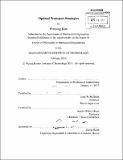Optimal transport strategies
Author(s)
Kim, Wonjung, Ph. D. Massachusetts Institute of Technology
DownloadFull printable version (10.20Mb)
Other Contributors
Massachusetts Institute of Technology. Department of Mechanical Engineering.
Advisor
John W. M. Bush.
Terms of use
Metadata
Show full item recordAbstract
It is generally presupposed that the shapes and mechanisms encountered in nature have evolved in such a way as to maximize the robustness of a species. However, most such optimization problems arising in biology are sufficiently complex that it is neither clear what is being optimized, nor what are the relevant constraints. We here consider a number of natural fluid transport systems that may be framed in terms of constrained optimization problems. We first examine natural drinking strategies. We classify the drinking strategies of a broad range of creatures according to the principal forces involved, and present physical pictures for each style. Simple scaling arguments are developed and tested against existing data. While suction is the most common drinking strategy, various alternative styles have evolved among creatures whose morphological, physiological and environmental constraints preclude it. Many small creatures rely on relatively subtle capillary effects for fluid uptake. Particular attention is given to nectar drinking strategies. Nectar drinkers must feed quickly and efficiently due to the threat of predation. While the sweetest nectar offers the greatest energetic rewards, the sharp increase of viscosity with sugar concentration makes it the most difficult to transport. An optimal sugar concentration is thus expected for which the energy intake rate is maximized. An extensive data set indicates that the sugar concentration that optimizes energy transport depends exclusively on the drinking technique employed. We identify three nectar drinking techniques: active suction, capillary suction, and viscous dipping and rationalize the reported optimal concentrations for each through consideration of the appropriate constrained optimization problem. Blood flow in vertebrates and phloem flow in plants are known to be optimized for efficient transport of oxygen and sugar, respectively. Efficient transport of material is similarly advantageous in engineered transport systems such as traffic and wireless networks. We thus develop a general framework for determining the concentration that maximizes the material flow in a number of transport systems.
Description
Thesis (Ph. D.)--Massachusetts Institute of Technology, Dept. of Mechanical Engineering, 2013. Cataloged from PDF version of thesis. Includes bibliographical references (p. 103-112).
Date issued
2013Department
Massachusetts Institute of Technology. Department of Mechanical EngineeringPublisher
Massachusetts Institute of Technology
Keywords
Mechanical Engineering.